PNG vs LPG: In Indian kitchens, the gas stove reigns supreme. While traditional earthen stoves have faded into history, the debate between LPG cylinders and piped PNG gas continues to simmer. This article will help you decide which fuel best suits your needs by explaining the pros and cons of each option.
Here are the Pros and Cons of LPG Gas Cylinders and PNG Gas Pipelines:
| Aspect | LPG Gas Cylinder | PNG Gas Pipeline |
|---|---|---|
| Pros | – Readily available | – Economical option |
| – Familiarity among users | – Delivered directly to homes | |
| – Provides consistent heat | – Operates at lower pressure | |
| Cons | – Higher cost | – Limited availability in some areas |
| – Higher pressure, potential safety risks | – Initial setup costs | |
| – Manual handling and cylinder replacement | – Dependency on infrastructure |
LPG Gas Cylinder
LPG gas comes in cylinders, typically containing 14.2 kilograms of gas. It’s a familiar sight in many households across India. The cost of an LPG cylinder varies but is generally around Rs 820 per cylinder. LPG is known for its high pressure, approximately 4200 millibar, making it relatively heavy and potentially hazardous if leaked.
PNG Gas Pipeline
PNG, on the other hand, is delivered through pipelines directly to homes. The cost of PNG gas is around Rs 41-42 per cubic meter. One kilogram of LPG is equivalent to approximately 1.564 standard cubic meters of PNG. Due to its mode of delivery, PNG gas is considered safer than LPG as it operates at a much lower pressure of only 21 millibar. In the event of a leak, PNG gas dissipates into the air, minimizing the risk of accidents.
Cost Comparison
When comparing the cost, PNG gas comes out as the more economical option. For the same amount of energy, PNG gas is approximately Rs 300 cheaper than an LPG cylinder. This cost difference makes PNG a preferred choice for many households, particularly those building new homes where the installation of PNG pipelines is feasible.
Safety Considerations
Safety is a crucial factor to consider when choosing between LPG and PNG. While both fuels are safe when used correctly, PNG gas has the edge in terms of safety due to its lower pressure and ability to dissipate into the air in case of a leak. LPG, being heavier, tends to linger in the surroundings, increasing the risk of accidents.












